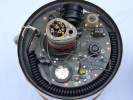|
SE 662
The Lifeboat transceiver SE 662 is self buoyant and has three rescue frequencies: (0.5 MHz, 2.182 MHz and 8.364 MHz).
It was built in 1962 and uses different housings.
It is used to send rescue messages and alarm codes verwendet, und dann zum Abwickeln des
resultierenden Notfunkverkehrs.
A built in automatic signal sender sends international distress signs and a continuous beacon signal
on the maritime distress frequencies 50 and 8364 kc.
On 2182 kc a signal for automatic watchkeeping stations can be sent.
the automatic signs are sent for two minutes; then the startion automatically switches to receive mode.
The signals provided by the built in morse key are in A2 mode, when the microphone is used, the signals are in A3.
 |
Front SE-662
[ <== Click picture ] |
The watertight orange- painted housing consists of Epoxy ???? and can be dropped into the water from a height of 9 meters.
The lower part contains 10 NiCad lye batteries, 12V and 7.5 A, with the charging connector.
The middle part contains the
electronc components, with the operational elements on the upper side. The device is water protected, when the lid is removed.
When not in use, the folded rod antenna is housed in a cylindrical chamber in the middle of the transceiver.
The upper lid contains a wire antenna, a dummy load, a screwdriver and a torch.
Both transmitter input stage and PA stage use tubes, the rest of the schematic uses transistors.
The transmitter is tuned using a variometer and an indicator lamp.
Each of these buoys has its own name. This one is called "S69 Habicht", another one I know of is called
"Plötze".
- Frequencies:
- Transmit: 0.5 MHz, 2.182 MHz, 8.364 MHz
- Receive: 0.5 MHz, 2.182 MHz

Technical data:
- HF output:
- 5 W
- Modes:
- CW: A2;
- Speech: A3
- Automatic signal sender: A2
- Tuned by:
- Variometer, operated by hand
- Sensitivity:
- 40 µV @ 1 mW
- Range:
- 0.5 MHz: 200 km
- 2.182 MHz: 320 km
- 8.364 MHz: depends on ionospheric conditions
- Active electronic elements:
- 2 tubes, 16 transistors
- Antennas:
- Foldable rod antenna 5.4 m
- Wire antenna 8 m
- Length of operation:
- 24 Std at transmitting/receiving 2min/10min
- Powered by:
- 5 NICad- Lye-batteries; 12V, 7.5 Ah
- Dimension and weight:
- Diameter 288 mm, Height 5 45 mm, 20 kg
|